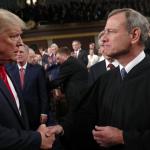Donald Trump’s Fight to Hide His Tax Returns Has Failed - Supreme Court Set the Course - Trump Has No Immunity

On Thursday, U.S. District Judge Victor Marrero threw out President Donald Trump’s challenge to a subpoena seeking his tax returns, a decision that all but guarantees a New York grand jury access to these documents in the near future. Trump will fight Thursday’s order, but he has run out of options: The Supreme Court already rejected his sweeping claims on immunity, then gave Marrero a road map that led ineluctably to a decision against the president. And soon, at long last, New York prosecutors will obtain the tax returns that he has fought so long to conceal.
New York County District Attorney Cy Vance reportedly began investigating Trump in 2018 for the illegal hush money payments that Michael Cohen made on his behalf. Since then, prosecutors have indicated that they are also looking into bank and insurance fraud by Trump and his companies. In 2019, a New York grand jury subpoenaed Mazars, Trump’s shadowy accounting firm, for eight years of financial records from both Trump and his businesses, including tax returns. The president, aided by the Department of Justice, intervened to quash the subpoena. Trump’s lawyers argued that sitting presidents are absolutely immune from state criminal subpoenas. Alternatively, they insisted that prosecutors should have to show a “heightened need” when subpoenaing the president, demonstrating that their action is a “last resort” to obtain information “not available from any other source.”
Chief Justice John Roberts’ opinion for SCOTUS, issued in July, rejected both these arguments. Roberts explained that nothing in the Constitution compels state prosecutors to show a “heightened need” for a subpoena of the president. Nor do the president’s constitutional powers shield him from a subpoena while in office. To the contrary, historical practice confirms that “the public has a right to every man’s evidence.” However, Roberts noted, a president may challenge a subpoena that is issued in bad faith if he can show it was designed to harass him. He can also defeat a subpoena by showing that it will impede his constitutional duties. The chief justice then sent the case back down to the lower courts, giving Trump an opportunity to raise these final objections.
Roberts’ decision was diplomatic: It confirmed that no one is above the law without immediately forcing Trump to comply with the law. But it was also a time bomb, because the chief justice surely knew that none of those objections had any merit in this case. The bomb went off on Thursday. Trump’s lawyers argued that Vance was engaged in a yearslong campaign of harassment against the president, a “fishing expedition” with illicit partisan motives. But they provided no credible evidence to back up their claims. As Marrero wrote:
This Court cannot mechanically credit allegations that a particular application of judicial process to the President is necessarily unduly burdensome and motivated by bad faith if, upon thorough and independent review, it fairly and compellingly appears that the claimed imposition on the President lacks plausible basis. … Given force, the relief the President seeks … would essentially extend the application of presidential immunity simply by virtue of a mere invocation that it is, after all, the President whose petition to be shielded from judicial process the Court is evaluating.
But the Supreme Court declined to extend such immunity to the president in Trump v. Vance. And Trump cannot get around that decision by lobbing vague and unsubstantiated accusations at prosecutors. That tactic might succeed on Twitter, but it does not fly in a court of law. Marrero explained:
The President’s response embodies a novel application of presidential immunity to protect the executive branch from judicial process. At its core, it amounts to absolute immunity through a back door, an entry point through which not only a President but also potentially other persons and entities, public and private, could effectively gain cover from judicial process.
Finally, Marrero noted, Trump failed “to raise claims based on identifiable executive policies or specific Article II duties” that might be hampered by complying with the subpoena. The president did not establish that turning over his tax returns would prevent him exercising his executive powers. He barely even tried—perhaps because a president who spends so many days tweeting his grievances cannot plausibly insist that an otherwise valid subpoena would somehow hinder his ability to lead the nation.
Marrero’s 103-page decision is a meticulous and scholarly response to the questions Roberts ostensibly left open in Vance. It is likely what the chief justice envisioned when he kicked the can to the lower courts. No one can say that the federal judiciary did not treat Trump with “the high respect that is owed to the office of the Chief Executive,” as Roberts put it. But respect for the president does not require courts to credit objections that lack all merit.
Trump’s inevitable appeal may help him run down the clock a bit longer: Marrero’s ruling will probably remain on hold while the federal appeals court—then, once again, the Supreme Court—review his conclusions. But Roberts is clearly done with this case and is unlikely to keep the subpoena on ice. That is, to put it mildly, bad news for the president. Less than one month before some Americans begin voting, a New York grand jury is poised to see documents that may prove Trump to be the head of a criminal enterprise.
[Mark Joseph Stern covers courts and the law for Slate.]
